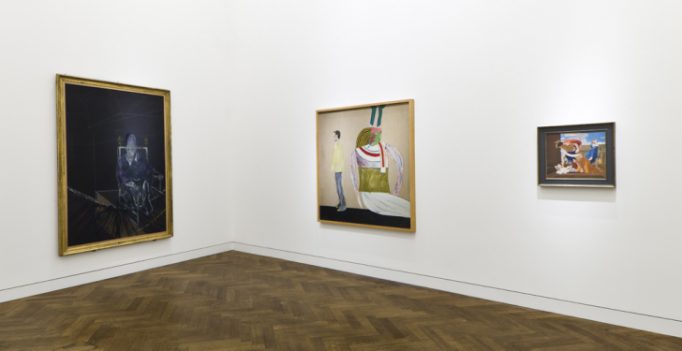Haunch of Venison, London, free, 07 Dec – 18 Feb 2012
In the company of masters
This was an excellent show containing paintings of different styles each artist being a master of their medium. On display are different treatments varying from the subtle, the photoreal and painterly to the gestural, violent and sublime. The subject matter differs greatly from painting to painting but the chief theme is of the human form and still life. From the Screaming Popes of Francis Bacon to the thick impasto style used by Auerbach.
Post war British art scene
The post war British art scene was one of diverse extremes, peculiarities and ambiguities. At the time Britain had strong leanings towards either abstraction or figuration where modernism still held the reigns of the art world quite tightly and would continue to do so for some time to come. This was an epoch where traditional fine art practices like painting and scupture ruled the day. Significant movements of the time included Pop Art, Op Art and Abstract Expressionism.
Paint and Technique
The work is realised in different scales from the small to the large and overbearing. There were many tendencies and schools floating around at this time all of which still viewed the painting as something which belongs on a wall, but there were breakaways from material and execution. Painters of this time were experimenting with surface using card, linen and other materials on which to paint, where grounds were not necessary and the painting itself did not have to be finished in appearance rather the unfinished quality allowed a greater space through which to channel messages and emotions that the artist may have wanted to convey.
Subject and form
The subject matter is mainly figurative and there are very few departures from this throughout the exhibition. The Mystery of Appearance, is a choice title however it could be more succinctly expounded by including a wider variety of experimental styles. David Hockney’s, ‘The Room at Tarzana’ 1967 may have been viewed as quite progressive for the time it very openly alludes to some kind of homosexual encounter which would have possibly been controversial at the time. However one might read it, today or back then, it is still a very precious rendition of human form and emotion treated with care and a certain delicacy.
Echoes
The work on display captures not only a unique moment in the past but a transient snapshot of moments to come in the wake of British Art as evinced by the departures from old traditions to the those of a more contemporary feel. Looking at the work by Hockney ‘The Room at Tarzana’ 1967 is redolent of Gauguin’s ‘Manao Tupapau’ 1892. Leon Kossoffs paintings had much in common with the German expressionists Ludwig Meidner’s Apocalyptic skies. So in as much as these artists broke with tradition there were clearly echoes of the past visible and discernible in the work. Likewise in the fashion of the ‘eternal return’ the contemporary itself cannot divest itself from the fetters of the anterior either and so goes on the progression of art history.
OUTLINE
Bringing together a strong collection of post war British art. The line up features Michael Andrews, Frank Auerbach, Francis Bacon, Patrick Caulfield, William Coldstream, Lucian Freud, Richard Hamilton, David Hockney, Leon Kossoff and Euan Uglow.
www.criticalmatters.net/reviews-view.html?review_id=91#mid-anchor
written by: Colin Humphrey
